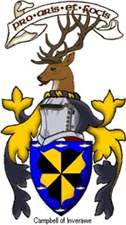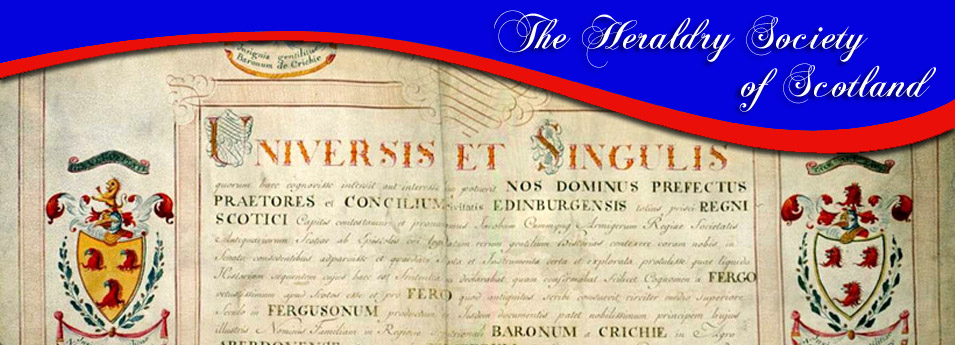|
|
| |
Scots Heraldry -The Heraldry
Society of Scotland |
. |
| |
|
|
| |
West Highland Heraldry -
The Meanings
| |
|
The Lion Rampant |
| |
| In the
back of his splendid book The Highland Clans, the late Sir lain
Moncreiffe of that Ilk charted the use of the Lion Rampant by
various families whose common origins lie in the Kingdom of
Scottish Dalriada. |
|
| I think
there is little doubt that the Lion is used as a reference to the
Royal Line of the Sons of Erc, Fergus, Loam and Angus who moved
across the North Channel in around 500 AD and established a major
extension of Irish Datriada in what is now Argyll. |
|
|
From here, in 843, King Kenneth
MacAlpine, under increasing weight of Norse attacks, moved
eastward to the Pictish Capital of Scone, his as well, by right of
his mother; from this move, of course, stems the origin of the
Kingdom of Scotland. With him went from Dunstaffnage not only the
Stone of Destiny but the lion coat which, as Sir lain has pointed
out, turns up in the arms of many of the great families of the
east of Scotland. and which derives ultimately from this source. |
 |
|
Wemyss
|
|
 |
|
Abernethy
|
|
 |
|
Hume
|
|
 |
|
Gray
|
|
|
 |
|
Dundas
|
|
 |
|
Dunbar
|
|
 |
|
Moncreiffe
|
|
 |
|
Spens
|
|
|
|
The Galley |
|
|
|
The Galley comes
in various forms; it may have its oars in action or crossed in
saltire; it may have a flag, a cross or a flaming beacon at the
masthead; it may or may not have a crew of various numbers; it may
be in, or out of the water; its sails may be furled or unfurled
and it may have a salmon crammed into the same quarter swimming
under it. |
|
|
|
Two of its most
famous appearances are as the Galley of the Isles and as The
Galley of Lorne used by two of the lines of Somerled's progeny -
the MacDonalds and the MacDougalls. But it was earlier in
use on the seals of the Isle of Man and there can be little doubt
that this is the symbol of Norse Royal power. |
|
|
|
Sir lain
Moncreiffe, indeed, derives it from the symbol used to denote
the male embodiment of the old pagan goddess-spirit Nerthus -
the Earth Mother - from whom the old Peace-Kings of Uppsala
claimed descent and whose symbol was a crescent-moon-shaped
Galley. This may be taking it a bit far - I don't know - but
the galley was the real instrument for the application of
power in these seas for many a century and its own symbolism,
I should have thought, was powerful enough. |
The Hand |
|
|
|
This, too,
appears in different guises. It may be on its own or it may be
holding a cross - usually a cross crosslet fitchy - or, in the
case of the Clan Chattan, sometimes a heart or a dagger.
But it is still The Red Hand? Best known today as The
Red Hand of Ulster, this is the ancient heraldic device of the
O'Neills, once High-Kings of Ireland who traced their descent
from Neil of the Nine Hostages. In conjunction with the
Cross it implies a connection with St. Columba himself a scion
of the O'Neills - The O'Donnell being the Coarb and Chief of
the Kindred of St. Columba. Niall of the Nine Hostages,
if indeed he existed, was early enough, but the Red Hand even
predates him in literature since it appears on one of the
anners o the Fiann in Ossianic poetry. |
|
|
|
The Salmon |
|
|
|
This is a most mysterious symbol
and one which is clearly of great importance. |
|
|
|
Salmon appear
frequently in early Celtic mythology as a symbol of Wisdom and
Knowledge. They are also a symbol of eternity with their
mysterious return to their birthplace from the outermost ocean
where they recommence the life cycle - also for their strength
and beauty. Their Knowledge springs from their having
eaten the red hazel nuts of Wisdom that fall into the water of
the sacred wells from the hazel trees that surround them - the
red spots on the salmon's belly derive from this. |
|
|
|
This
knowledge can be passed on by eating the flesh of the salmon A
famous instance of this was the case of Finn MacCool, the
mythical leader of the Feinn, the war-bands of young men whose
deeds are commemorated in the heroic poetry that is said to
spring from the composition of Finn's son Ossian. His great
rival was Diarmid whose death he eventually encompasses.
And of course there is the famous story of Somerled himself'
whose decision to take on the Norse is said to have been taken
as a result of his finally catching the salmon that had long
eluded him. |
|
|
|
In many
civilisations it is the serpent who is endued with magical
powers but in Ireland there are no snakes and it is the salmon
that takes its place. They have connotations with
immortality and when an Irish King defeated another, a ritual
killing of the fish in the vanquished king's stew-pond took
place. Even today, the salmon is a Royal Fish and Salmon
fishing rights are retained by and dispensed by The Crown
Clearly it is a powerful symbol. To my mind there is a pagan
feel to it; I do not think it is the txoua of early
Christianity and wonder if it is not a reference to the Old
Religion of the Celts, or more accurately, to a person or
family connected with it. |
|
|
|
|
On a different note, I have
been told by Professor Per Andraesson that although the
salmon is a rarity in Norse heraldry he has seen a coin
dating back to Jutland in the 8th century which has both a
salmon and a galley on it. And even today its use is
clearly important to status. When MacCailein Mor goes to
the Oban Ball he is clad in a doublet decorated with
silver salmon as is Maclean of Duart. And the Campbell
chief also displays the mysterious salmon semee on his
Standard. I mentioned earlier the Campbells of
Inverawe and the six salmon that decorate the border of
their gyronny coat. |
|
|
|
There are two 17c stones at Ardchattan Priory for
members of the same family that give a coat with a
gyronny in each of their four quarters - and a
salmon stuffed in underneath them in base.
Also at Ardchattan is the early achievement of
Maclntyre of Glennoe which in irregular form show
a stag about to be transfixed by an arrow, a
galley - and, yet again, a salmon. The Clanranald
stone at Arisaig displays the same phenomenon with
the salmon forced in at the base of the quartered
shield. Whatever the salmon represents it is
obviously of considerable import and it is all the
more mysterious that we have apparently forgotten
its meaning. |
|
|
|
 |
|
|
|
 |
|
Campbell of Inverawe
|
|
 |
|
Campbell of Inverawe
|
|
 |
|
MacIntyre of Glenno
|
|
 |
|
Clanranald Stone |
|
|
|
|
|
Next
Page |
|
Pages
1 2 3 4 5 |
|
|
|
|
|
|
© The Heraldry Society of
Scotland last Update
27 Oct 2021 |
|
